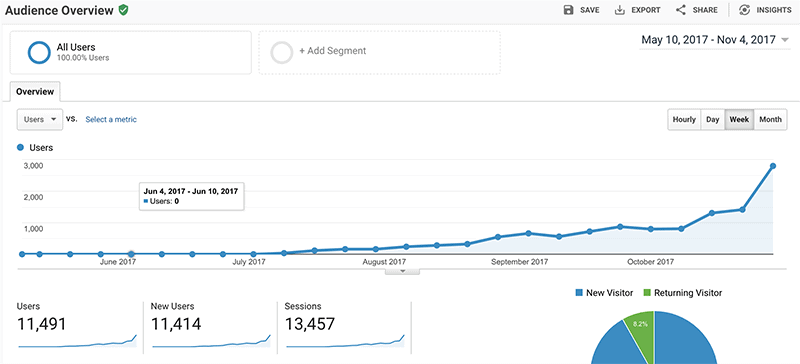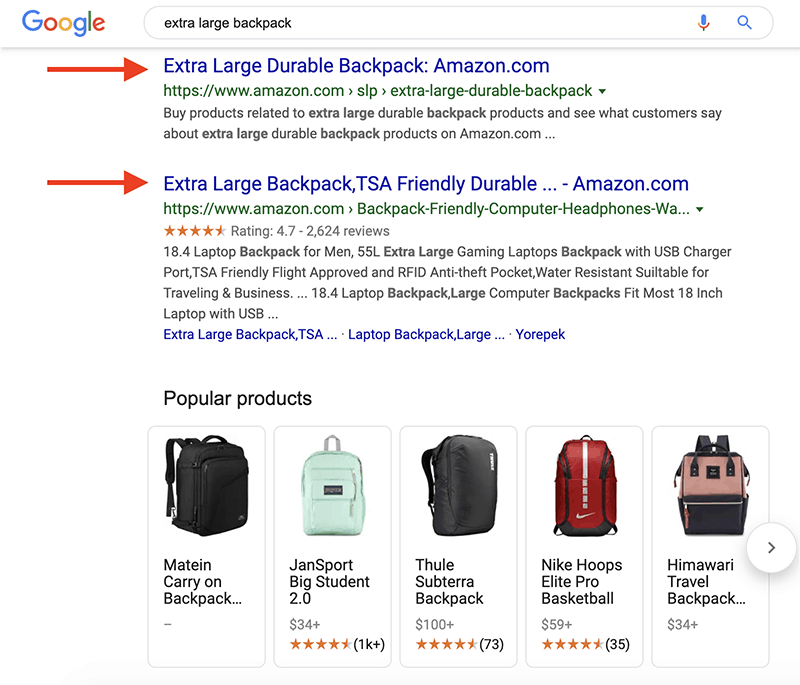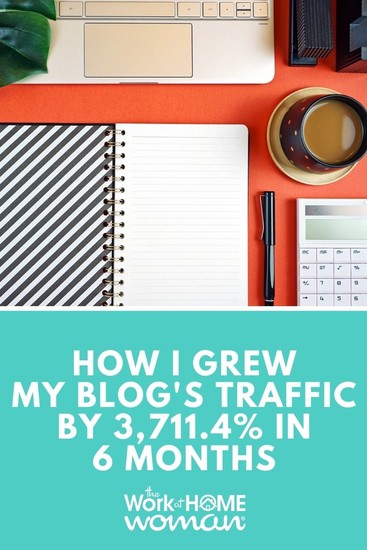Let’s get one thing straight: There are no shortcuts when it comes to growing your blog traffic.
That being said, you can see massive progress over a period of a few months with good content and legitimate SEO techniques.
For example, I was able to increase my blog traffic by almost 4,000% in just half a year.

In this guide, I’m going to breakdown exactly how I was able to skyrocket my traffic while providing an outline that you can repeat for your own website.
Let’s begin!
 The Four Phases of a Blog
The Four Phases of a Blog
The backbone of the system is divided into four phases:
- Plan
- Create
- Optimize
- Promote
By following these steps, I was able to go from zero traffic on my site to more than 40,000 total organic sessions in just six months.
Sounds simple enough, but it’s obviously more complicated than those four basic steps, so I’m going to break them down for you.
1. Planning Blog Content from Nothing
Blindly creating content is a sin in marketing, especially SEO.
Sure, delivering the best content for users should be a priority, but users won’t see your blog if you don’t properly plan the framework.
With that said, I have two pillars of planning that I follow before ever typing a word of content:
- Keyword Research
- Competitor Research
I always like to start my content planning by researching keywords.
Keyword Research
Keyword research is an essential part of the planning process.
If you’re unfamiliar, keywords are words or phrases that are entered into search engines (like Google).
The best keywords have high search volume (monthly searches) while also having a low keyword difficulty (level of competition for that phrase) at the same time.

Above is an example of a great keyword on Ahrefs, which is an SEO tool that I use for my own keyword research and competitor analysis.
The lower a keyword’s difficulty is, the easier it will be to rank for.
Simultaneously, keywords with higher search volume will bring in more users — assuming you can rank high enough for that phrase!
However, traffic and competition stats alone don’t make a “good” keyword.
The best keywords are ones with the right search intent. This means understanding what people actually want to see when they search for that word or phrase and preparing your blog post accordingly.
For example, let’s say you find a keyword that you could write a blog post around: “extra-large backpack.” This keyword checks out on Ahrefs with flying colors, but there’s one problem.
When you Google this keyword, you find that the top-ranking sites aren’t blogs. In fact, every blog on this subject is ranked much lower. Instead, the top 10 results are dominated by eCommerce stores like Amazon, Walmart, and Target.

This is because of the user search intent. Google will rank what users want to see, and when users want content that isn’t a blog post, blogs won’t rank. In this case, Google knows people searching for an “extra-large backpack” want to buy a backpack.
On the other hand, if the keyword is “what’s the best backpack for travel,” users are looking for an informational post about travel suitcases.
Further still, the keyword “best travel backpack” will return list-style posts that round up the top 10 best travel backpacks, for example:

The lesson?
Find keywords that blogs are already ranking for. You may be intimidated by the competition, but don’t worry: If you create a blog post that Google determines is the most informational and the best result for the user, you’ll rank!
Analyze Competition
Similar to finding user intent, we can look at our competition to see what it will take to outrank them.
For now, ignore the backlinks and the authority of those top websites. Everyone starts somewhere, and you won’t get anywhere if you spend your energy stressing over the technical stats of your competitors.
Instead, study their content. Look at how valuable their information is, and how easy it is for a beginner to digest.
Ask yourself: “How can I make better content than this?”
After all, one of Google’s biggest ranking priorities is where users prefer to go. If people find your page more useful than the other guys, your rankings will reflect that.
Once you have all of your keywords and competition stats recorded in a spreadsheet, you can move on to implementing the plan to create great blog posts.
Side note:

You can also do more keyword research for content ideas by using “Top Pages” in Ahrefs. This will show your competitors’ top keywords at that moment.
2. How to Create the Best Blog Content for Users
Ok, so we have our plan set, and now it’s time to smoke your competition with the best content available to users.
What does the best content look like?
Here are my three pillars for creating blogs:
- Writing
- Editing
- Graphic Design
The more planning you put into your content, the easier it will be to execute the three pillars of creation.
Whether you’re writing the posts yourself or you have a writing team at your disposal, planning, and creation go hand-in-hand.
That said, let’s breakdown my first rule to creating exceptional blog content.
How to Ensure the Most Effective and Efficient Writing Process
The best content translates the most information that can be processed in the quickest and easiest way.
To elaborate, here are four points to put on your content checklist:
- Easy to read: I like to read content out loud to test how natural it sounds. Running content through a text-to-speech tool works as well.
- Well-written: Can your grandmother read this and understand the information? How about your neighbor? Make sure your content is digestible by a beginner in your field.
- Valuable information: What does your content leave the reader with? What does it teach them? People won’t waste time on content that isn’t valuable.
- Direct: Sure, having the highest word count can help rankings, but only if every word delivers value. Say the most with the least.
I follow each of these points religiously, and users appreciate that my content is tailored to them.
Often, it’s easy to focus on the technicalities of content and then neglect the most important thing, which is the writing itself.
If you can take pride in your writing, you’re on track to ranking #1. Focus on the tiny details later!
Editing
Editing mostly pertains to content creators who outsource their writing.
Even if your team is compiled of outstanding writers, having a second pair of eyes to look over someone’s work is always beneficial.
If you don’t have time to edit the work yourself, don’t be afraid to hire an editor for $.02 per word. This may seem excessive, but everyone makes mistakes, and your writers won’t improve if they can’t see theirs.
After all, nobody is a perfect writer!
In fact, you shouldn’t skimp on hiring in general. One lesson I learned recently is that you get what you pay for.
When I began to outsource my content, I would hire non-native English-speakers for just $.03 per word. Sounds pretty sweet, right?
Well, the reality of the situation was that I ended up spending more time editing the writing than it would have taken to write the content myself.
If you aren’t willing to pay for good writing, write the content yourself.
If you want to make sure your content is top-notch, it’s best to write it yourself or at least mostly yourself.
Custom Graphics
Possibly one of the most powerful, yet neglected, tactics for creating amazing content is the use of custom graphics.
It has been shown that people retain visual information thousands of times faster than reading written text.
You’re probably thinking: “Great, not only does this guy want me to spend more money on writing, but now he wants me to invest extra funds into graphics?”
Well, yes! Here’s why: Graphics aren’t just a pretty asset for your users to look at, they’re also linkable assets.

A linkable asset is a useful feature on your page that can’t be found anywhere else. These assets are linkable because when a foreign site sees your awesome graphic, they might share it.
When another site posts your graphic on its blog, it delivers backlink authority. That link could be worth hundreds of dollars based on the traffic and authority that it will bring you — and you paid a Fiverr freelancer 10 bucks for it.
Now, you shouldn’t expect graphics to deliver links, even though they can.
Instead, think of it as an awesome feature on your page that will make your users happy. Content should be your priority, and user experience determines the value of your content.
3. Optimize Existing Blog Content
Unless you are optimizing your content for Google, no one will see it.
This can be really unfortunate, especially when you have genuinely valuable content that can help people.
Now, you could go out and hire an SEO consultant to boost your site, but if you optimize your content from the beginning, you won’t have to spend thousands of dollars later.
How to Utilize On-Page SEO Tactics
First, do what makes sense to the user. This means on-page SEO tactics like:
- Use both a title and heading tag that includes your target keyword, while also being intriguing to users.
- Implement a meta description that answers or describes the target keyword immediately.
- Embed alt tags into images. These tags should be a basic description of the image in as few words as possible.
- Optimize page speed with lazyloading, compressing images, and using WebP.
- Sprinkle LSI keywords into your text (especially subheadings).
- Make your content well-organized and easy to read.
The Best Layout for Blog Posts
The organization of a blog post very well could make-or-break the difference between #1 and #2 rankings.
The first tactic I follow to deliver the most user-friendly layout is to separate my sentences.
It’s been shown that having bulk text discourages users compared to single or double sentence paragraphs.

Which of these would you prefer to read?
Another tip for a good layout is an appropriate amount of images. Too many photos will seem spammy, while not enough could come off as boring to read.
Usually, one image per window (as in always having an image on screen when you’re scrolling) is a good balance, but you can use your best judgment for user experience here.
The next tip is bucket brigades.
What’s a bucket brigade?
Actually, that question was a bucket brigade. It’s a statement with the purpose of keeping users interested in reading further.
Lastly, you need to focus on headings.
Every subheading has a purpose. They should:
- Organize your content
- Target LSI keywords
- Target a featured snippet
I know all of this seems like a lot, but if you can manage to implement every one of these SEO tactics, your rankings will reflect all of your hard work, and you’ll be ahead of 90% of the game.
4. Promote the Finished Product
You’ve gone through the content grind to create the best blog post for yourself and your users — now it’s time to get the word out.
Having a solid backlink outreach system is an invaluable asset to your website.
Although there are plenty of opportunities to purchase backlinks online, DON’T!
Unless you’re going through a well-known, trustworthy organic backlink outreach professional, never try to buy backlinks online. These links are often not very beneficial to your site and could get you penalized by Google.
The best way to get backlinks legitimately is to reach out to blog owners in your niche space and offer them a guest blog post in exchange for a link to your post from theirs.
5. Bonus Tips
In this section, I want to give you some productivity hacks that helped me accelerate my blog’s growth.
Create a Good Project Roadmap
It’s essential to create a sound project roadmap before you begin.
You want to plan out what you’ll do and when before you start so you can measure your progress.
For example, if you want to write four blog posts per week for the first three months and then promote your content afterward, schedule it out!
You need to have sound KPIs to measure your progress and make sure you’re staying on track. Growing a blog isn’t easy, and development may seem slow at first.
By measuring your progress, you’ll be able to feel accomplished with your work, even if you’re not pulling in traffic yet.
Use a Task Manager

Using a task manager is a great way to stay on track with your project roadmap. I use Monday.com to manage my team, but if you want to use a free task manager, I highly recommend Trello.
You can create boards and add your team members (if you have any) to schedule content, videos, and other tasks you need to complete.
It’s a great way to track your progress, hit your deadlines, and grow quickly.
Invest in a Good Computer
When I started blogging, I was using my 8-year-old laptop.
Believe me when I say it was a HUGE pain. My PC took ages to boot up, and then I had to wait even longer before it “warmed up.”
Constant freezes and crashes are annoying when you’re trying to work online. You don’t need to spend a fortune on a computer that can handle virtual reality to get the job done, but don’t use something from the stone age either.
I recently invested in a great travel laptop that’s lightweight, super-fast, and ultra-portable (it was worth every penny!)
The time and energy you’ll save using a capable computer is well worth the initial investment.
Work in the Right Environment
I know this may sound counterintuitive – working from home is the whole point of blogging, right?
Sure, if that’s what you want. The beauty of working for yourself — especially as a blogger — is having the flexibility to do what you want with your time.
If you want to work from home, go for it. I choose to drive down the road to my local coffee shop or cafe instead. When I work at home, I find myself easily distracted by TV, YouTube, texting, video games… the list goes on.

Conversely, when I drive to a local cafe, I’m in a great working environment. I go there with a purpose, and I don’t leave until all of my work is complete. It also helps me stay on task.
But again, this is totally up to you!
Travel
Starting a blog isn’t easy. It takes discipline and patience, but if you do it right, you’re going to totally change your life.
Blogs are a great way to generate passive income and become completely location independent. This means you can work from home or anywhere else in the world, as long as you have a WiFi connection.
Most travel bloggers use their blogs as their full-time source of income. But even if your blog isn’t making a full-time income quite yet, you can live abroad affordably by doing programs like Workaway. You volunteer your time at a host’s home, hostel, farm, garden, etc. in exchange for free room and board. I did it for a month in Israel, and it was a great experience. If you want to check out a full Workaway review, click here.
Reward Yourself
It’s important to not only set goals but also to create healthy habits that propel you towards those goals.
The thing is, good habits tend to have longer-term benefits, and bad habits usually have instant gratification. That’s why working out in the gym and starting a passive income blog take time before you see significant results. But if you keep it up, you’ll be in great shape over time (both financially and physically).
Conversely, bad habits (like eating cake every day) have immediate rewards but a net negative impact over time.
The point is, it’s easy to get off track and go back to your old ways (not working on your blog consistently) if you don’t reward yourself along the way here and there.
This is the case for any habit you’re trying to form, but it is especially handy if you want to grow a successful blog.
If you’re interested in a great read about healthy habit building, I highly recommend the book Atomic Habits. It’s definitely a book to add to your reading list if you’re entrepreneurial at heart or just want to build healthy habits.
Conclusion
Well, you’ve done it.
You’ve read every detail of how my guide to increasing traffic to your blog site.
Keep in mind that I use these exact same tactics for myself, and if you follow my advice to a T, your traffic will spike for sure.
Just remember: The best content will come out on top, and never take shortcuts with your blog SEO!
You’ll Also Love These Posts:
Studies have shown if you like this blog post — you will also love the following articles. I handpicked them just for you!
- 8 Actionable Ways to Increase Engagement on Your Blog
- The Best Blogging Tools and Resources For Profit Generating Blogs
- How to Start a Blog and Make Money From It
After growing up in a small town in the country, Jacob Tuwiner hit the road at the age of 19 to pursue his online business. He spent seven months in seven different countries, working remotely and exploring the world. He loves all things SEO, and aspires to help others take control of their lives. Whether you want to live as a digital nomad and travel full time, or just work from home, I firmly believe ditching your desk and escaping the 9-5 is possible if you put your mind to it.
This page includes affiliate links. Please be aware we only promote advertising from companies that we feel we can legitimately recommend to our readers. Please see our disclosure policy for further information.








Hi Holly, I have just stumbled on your website and it has so many information for me to learn online blogging.
Glad you’re here, Gina!
All the best on your blogging journey!
Hi Holly, great tips! I did a lot of redoing old blog posts and adding internal links. It has increased traffic.
Now I have to work more on the SEO angles.
How far advance do you plan for content? Thanks.
Hey Lisa,
So glad you enjoyed Jacob’s tips!
I’m usually a month ahead on content creation. But sometimes inspiration hits, and I’ll publish on the fly.
My next big SEO undertaking is a site redesign (which I’m excited and nervous about). I’ve been blogging for almost 11 years, and there are some aspects of the blog that need a major overhaul.
Thanks for popping by!
Hi My Name Is Savannah Rush. I’m trying to get my blog business up and off the group and wanted to connect with someone who could help succeed in helping me do so. And i came across your website.
Hi Savannah,
What do you need help with, writing content, SEO, marketing?
In my free blogging e-book, I have tips for getting traffic, creating content, and monetization.
You can sign-up for it here: https://www.theworkathomewoman.com/work-at-home-make-money-blogging/
Good luck!